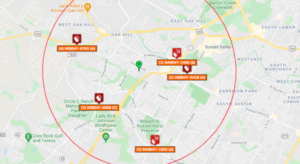So, I was scrolling through some charts the other day and noticed something kinda wild—prices were jumping around faster than usual. At first, I thought it was just a momentary blip, but then it hit me: if you’re not keeping tabs on your tokens with real-time data, you’re basically flying blind. Seriously, in the world of DeFi where seconds count, lagging behind can cost you big time.
Here’s the thing. Tracking token prices isn’t just about watching a number tick up or down. It’s about understanding the market’s pulse—seeing how liquidity shifts, spotting unusual volume surges, and catching those sneaky whales making moves. Without that, you’re missing the forest for the trees.
At first glance, I figured traditional price aggregators would cut it. But nah, they’re often too slow or too generalized for the nuanced dance of decentralized exchanges. You need something sharper, something designed for the chaos of DEXs.
Whoa! That’s where tools like the dexscreener app come into play. It’s not just a fancy dashboard; it’s a real-time window into token liquidity, price action, and order book dynamics across multiple decentralized platforms.
But wait, I’m getting ahead of myself…
Digging deeper, I realized most token trackers lack detailed DEX analytics. They show price, sure, but ignore how liquidity pools behave or how slippage might affect your trades. This gap is huge for traders like me. (Oh, and by the way, that’s the part that bugs me the most—missing context leads to poor decisions.)
Okay, so check this out—imagine you’re eyeing a freshly launched token. The price looks promising, but you’re not sure if the liquidity is healthy or if it’s just a pump-and-dump setup. Using a regular price chart, you’d be guessing. But with a tool that offers deep DEX insights, you can see liquidity depth, token pair ratios, and even recent large transactions in real-time.
Initially, I thought relying solely on on-chain data was enough. But then I realized that without aggregating across different DEXs, you miss arbitrage opportunities and fragmented liquidity pools. On one hand, focusing on a single exchange simplifies things, though actually, it leaves gaps in the bigger picture.
So, the real power lies in a DEX aggregator that not only tracks prices but also consolidates liquidity data from multiple sources. That way, you get a comprehensive view and can make smarter, faster trades.

Here’s where the dexscreener app really shines. It pulls data from all major decentralized exchanges, giving you up-to-the-second feeds on token prices, volume, and liquidity pools. Honestly, it feels like having a trading floor ticker in your pocket—minus the noise and chaos.
One of my favorite features is the ability to filter tokens by real-time liquidity changes. That’s clutch when you want to avoid tokens that might dry up mid-trade or get rug-pulled. Plus, seeing price impact estimates before confirming a swap saves me from nasty surprises—my instinct said this would be useful, but actually, it’s been a lifesaver.
Something felt off about relying on manual tracking tools or spreadsheets. They’re slow and prone to error, especially when markets move this fast. The difference between a 2-second delay and instant data can mean hundreds of dollars lost or gained.
Now, I’m not 100% sure if every DEX aggregator is created equal, but from my experience, the depth and speed of analytics are what separate the pros from the amateurs. It’s like sports—watching the game live versus reading the highlights days later.
Sure, the learning curve can be steep. Some of these apps throw a ton of data at you, which can be overwhelming. But once you get the hang of reading liquidity graphs and understanding volume spikes, it’s a whole new ballgame. Plus, tools like the dexscreener app often come with user-friendly interfaces that help bridge that gap.
Why Decentralized Exchange Analytics Matter More Than Ever
Think about it: central exchanges have order books and established market makers, but DEXs operate differently. Liquidity pools shift constantly depending on user deposits and withdrawals. Prices can vary across platforms. So, if you’re only tracking one exchange, you’re missing a big chunk of the market.
My first real aha moment came when I noticed a token’s price spiked on one DEX but stayed flat on another. At first, I thought it was a glitch, but nope—different liquidity conditions and user behavior caused the divergence. That insight made me realize the absolute necessity of multi-DEX tracking.
Hmm… on the flip side, that complexity means you can’t just blindly trust any single source. It takes a bit of savvy to interpret the data properly. But that’s part of what makes DeFi trading exciting and challenging.
Sometimes, I catch myself obsessing over tiny price differences and forget the bigger picture—like overall market sentiment or upcoming protocol updates. So, the data tools are critical, but they’re just one piece of the puzzle.
And man, when you combine real-time token price tracking with deep DEX analytics, you get a strategic edge that’s hard to beat. It’s like having a radar for market manipulation, liquidity squeezes, and even whale moves.
In fact, I’d argue that any serious DeFi trader who isn’t leveraging such tools is handicapping themselves. The market doesn’t wait, and neither should you.
By the way, the integration of these analytics into mobile-friendly apps—like the dexscreener app—means you can monitor your portfolio and market conditions anytime, anywhere. That flexibility is huge, especially if you’re juggling other commitments.
Still, I gotta admit, sometimes the sheer volume of data can be overwhelming. You start chasing every little movement, and it gets exhausting. So, there’s a balance to strike between being informed and being paralyzed by info overload.
Something else I’ve noticed: these tools improve over time as they incorporate user feedback and new data sources. So, the landscape is evolving fast. It’s worth keeping an eye on updates and new features.
Honestly, I’m biased, but I think we’re just scratching the surface of what real-time DEX analytics can do for DeFi trading. The future might hold even more granular insights—like predictive analytics or AI-driven trade suggestions—which would be wild.
Anyway, if you haven’t checked out the dexscreener app yet, give it a whirl. It’s one of those tools that once you start using, you wonder how you ever traded without it.
So, where does that leave us? Well, real-time token price tracking combined with comprehensive DEX analytics isn’t just a nice-to-have—it’s a must-have for anyone serious about DeFi. It cuts through noise, highlights real opportunities, and helps dodge costly mistakes.
My instinct says this trend is here to stay, and the tools will only get smarter and more intuitive. I’m curious how this will reshape trading strategies over the next few years.
Anyway, that’s my two cents. I’m still learning and tweaking my approach every day. But one thing’s clear: real-time, multi-exchange token tracking is a total game-changer.




